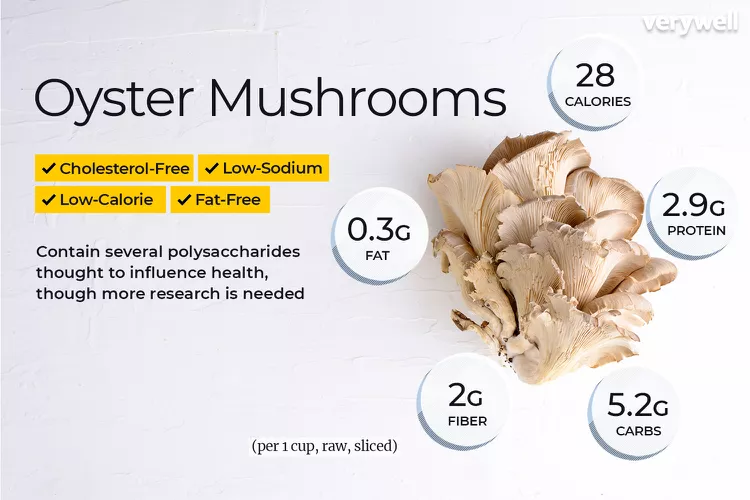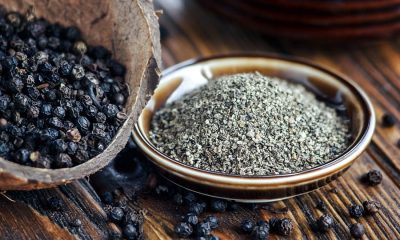Food
5 Benefits of oyster mushrooms and side effects

Table of Contents
Mushrooms, such as the lion’s mane mushroom and cordyceps, have been used as natural remedies in many countries for thousands of years and have become a staple in many different cultures and cuisines.
The oyster mushrooms, on the other hand, are one of the newest fungi which have recently appeared but still have become a favorite of many fungi because of their distinctive taste and extensive health benefits.
Formally known by its scientific name Pleurotus ostreatus, the oyster mushroom is named for its shell-like appearance and resemblance to oysters.
It is highly versatile, with a mild taste and licorice aroma, and has quickly become an integral part of many Asian dishes, from soups to sauces and much more.
This unique mushroom has been cultivated for less than 100 years, and scientists are beginning to scratch the surface of the many potential benefits it has to offer.
So far, however, the results have been promising, showing that it can benefit everything from inflammation to heart health.
Health benefits of oyster mushrooms
1.- Benefits of oyster mushrooms for cholesterol
Cholesterol is a waxy, fat-like substance found throughout the body and is essential for health.
Cholesterol is an important component of cell membranes and is required for the synthesis of cholesterol, bile acids, and certain vitamins and hormones.
However, excess cholesterol can build up in the blood, forming fatty deposits in the arteries and increasing the risk of heart disease and stroke.
Oyster mushrooms have been shown to help lower cholesterol naturally and quickly in some animal studies.
A study published in the journal Mycobiology, for example, showed that supplementation with oyster mushrooms helped reduce total cholesterol levels by 37 percent and reduce triglycerides by 45 percent in rats.
Still, more studies are needed to determine how oyster mushrooms can affect cholesterol levels in humans.
These mushrooms have gained ground in recent years, thanks to the benefits they can bring to health care
2.- Benefits of oyster mushrooms for inflammation
Inflammation is a normal immune response designed to protect the body against infection and disease.
On the other hand, chronic inflammation is believed to be associated with an increased risk of diseases such as cancer, heart disease, and diabetes.
Oyster mushrooms have been shown to possess powerful anti-inflammatory properties.
According to one study, oyster mushrooms were able to reduce the secretion of multiple inflammation markers in the body.
This could have far-reaching benefits, as decreasing inflammation can help alleviate many inflammatory conditions ranging from rheumatoid arthritis to inflammatory bowel disease.
3.- Packed with antioxidants
Antioxidants are compounds that help fight free radicals and prevent damage to cells.
Research suggests that antioxidants may play a central role in health and disease and can help fight oxidative stress to reduce the risk of certain chronic conditions.
Some studies have found that oyster mushrooms are loaded with health-promoting antioxidants, which may explain their many health benefits.
Both test-tube and animal studies have shown that oyster mushrooms are effective in increasing antioxidant levels in the body and neutralizing harmful free radicals.
4.- Benefits of oyster mushrooms for cancer
One of the most impressive benefits of oyster mushrooms is their powerful effect on cancer cells.
Thanks to their high antioxidant content as well as their anti-inflammatory properties, oyster mushrooms can help inhibit the growth of certain types of cancer, making oyster mushrooms possible cancer-fighting foods.
One study found that oyster mushrooms were able to inhibit the growth and spread of breast and colon cancer cells.
Similarly, another study showed that oyster mushroom extract had therapeutic effects against colorectal tumor cells and leukemia.
5.- Benefits of oyster mushrooms for brain health
Believe it or not, what you eat can have a huge impact on your brain health and can even influence your risk for neurodegenerative diseases and dementia.
Certain vitamins and minerals, in particular, are especially important when it comes to brain health.
Oyster mushrooms are rich in many of the nutrients that are believed to improve brain function.
Niacin, for example, has been shown to protect against Alzheimer’s disease and cognitive decline in older adults in clinical research.
Meanwhile, a review suggested that riboflavin supplementation might have therapeutic effects against Brown syndrome, a type of motor neuron disorder.
Nutrition facts of oyster mushrooms
Take a look at the nutrition profile of oyster mushrooms, and it’s easy to see why they are so good for you.
They are extremely low in calories but contain a good amount of protein, fiber, niacin, and riboflavin.
One cup of sliced oyster mushrooms (approximately 86 grams) contains approximately:
• 37 calories
• 5.6 grams of carbohydrates
• 2.8 grams of protein
• 0.4 grams of fat
• 2 grams of dietary fiber
• 4.3 milligrams niacin (21 percent DV)
• 0.3 milligrams riboflavin (18 percent DV)
• 1.1 milligrams pantothenic acid (11 percent DV)
• 103 milligrams phosphorus (10 percent DV)
• 361 milligrams potassium (10 percent DV)
• 0.2-milligram copper (10 percent DV)
• 0.1-milligram thiamine (7 percent DV)
• 23.2 micrograms folate (6 percent DV)
• 1.1 milligrams iron (6 percent DV)
• 0.1-milligram manganese (5 percent DV)
• 0.1-milligram vitamin B6 (5 percent DV)
In addition to the nutrients mentioned above, oyster mushrooms also contain a small amount of magnesium, zinc, and selenium.
Types of oyster mushrooms
If you are looking to add oyster mushrooms to your diet, there are a few different options to choose from.
Oyster mushrooms are considered the most common type of mushroom and are used for cooking throughout the world.
The blue oyster mushroom is another widely available variety, which starts dark blue and gradually lightens as it matures.
Note that several types of mushrooms have “oysters” in the name but are different from common mushrooms.
For example, king oyster mushrooms, also known as king trumpet mushrooms, are closely related to the oyster mushroom but belong to a different species of mushroom.
These mushrooms have a meaty umami flavor and are often used as a vegan-friendly meat substitute in some recipes.
Golden oysters, pink oysters, and blue oysters are other examples that belong to the same genus as oyster mushrooms but have minor differences in taste, texture, and appearance.
Oyster Mushrooms vs. Maitake Mushrooms
Like oyster mushrooms, maitake mushrooms are abundant in many types of Asian cuisine, including Japanese and Chinese cuisines. They can be served as a garnish, in a savory sauce, or added to soups.
One of the most notable differences between maitake mushrooms and oyster mushrooms is their appearance.
Maitake mushrooms have distinctive feathers, like leaves, while the caps of oyster mushrooms resemble a shell.
There are also some differences in taste, as maitake provides a richer, earthier flavor than oyster mushrooms, which tend to be softer and more delicate.
However, there are many similarities when it comes to nutrition. Both are low in calories and contain a generous dose of B vitamins, such as niacin and riboflavin.
However, oyster mushrooms contain twice the protein per ounce and are also slightly higher in certain micronutrients like phosphorus and potassium.
Aside from their nutrient profile, maitake mushrooms are also revered for their medicinal properties.
They offer a slightly different set of benefits than oyster mushrooms and have been shown to boost immunity, help treat cancer, improve blood pressure, and reduce symptoms of diabetes in both animal and test-tube studies.
Both types of mushrooms can be nutritious additions to the diet and can be enjoyed in many different recipes.
Try increasing your intake of both to take advantage of the unique nutrient and health benefits each has to offer.
Uses of oyster Mushroom
Oyster mushrooms have a mild flavor with a delicate flavor and a licorice aroma that is often compared to anise seed.
They are popular for their tender and smooth texture and are versatile enough to swap in almost any recipe.
Also, like other types of mushrooms, such as cremini mushrooms, oyster mushrooms can be enjoyed raw or cooked.
These mushrooms are frequently found in many types of Asian cuisine, including a variety of Japanese, Korean, and Chinese dishes.
They have also made their way into the kitchens of other countries around the world, such as the Czech Republic and Slovakia, where oyster mushrooms are sometimes used to provide a meaty texture and flavor to traditional stews.
Oyster mushrooms can be seasoned and served alone for a tasty side dish or added to soups and stir-fries.
They can also increase the taste and nutritional value of recipes such as hamburgers, pasta, or omelets.
If you don’t have the means to start hunting or growing oyster mushrooms in your backyard, you’re in luck.
Thanks to their growing popularity, oyster mushrooms are now available in many grocery stores and farmers’ markets.
They are typically available fresh, dried, or even canned for a quick and convenient addition to your favorite recipes.
The price of oyster mushrooms can vary widely, but it tends to be comparable to other types of mushrooms such as shiitake mushrooms. In general, you can expect to pay between $ 10 and $ 12 for a pound of fresh oyster mushrooms.
Story
Oyster mushrooms were originally grown in Germany during World War I as a livelihood when food was scarce.
Today, these nutritious mushrooms can be found wild in North America, Europe, and Asia, and are also grown for commercial use around the world.
With their white, shell-like appearance, oyster mushrooms got their name due to their similarities in appearance to the oyster.
Not only do they look alike, but oyster mushrooms also share a similar flavor to this popular type of bivalve.
These fungi are considered saprotrophic, which means that they feed on dead and decaying material, such as wood.
The cap can grow between two to 10 inches in size and can range in color from white to dark brown.
Interestingly, the oyster mushroom is one of the few types of mushrooms that are considered carnivorous.
These fungi release an attractive-smelling chemical to draw microscopic nematodes, then use their mycelia to paralyze, kill, and digest the creatures as a way to obtain nitrogen.
Even more surprisingly, scientists didn’t realize that oyster mushrooms were consuming meat until the 1970s, and the discovery was made by accident.
Scientist George Barron had been collecting and studying different types of carnivorous fungi from the soil and began growing them in Petri dishes in his laboratory.
However, a Petri dish was forgotten for more than six months and was eventually found by a laboratory technician.
In that period, the mushroom produced a mushroom, which was identified as the oyster mushroom, leading scientists to realize that oyster mushrooms can consume meat and wood.
Side effects of oyster mushrooms
Some people may be allergic to fungi and other types of fungi. If you experience any food allergy symptoms like hives, bloating, nausea, vomiting, or cramps after eating oyster mushrooms, stop using them and talk to your doctor.
Also, oyster mushrooms contain a very small amount of arabitol, a type of sugar alcohol that can cause gastrointestinal symptoms in some people.
If you find that you are sensitive to sugar alcohols or are following a low-FODMAP diet plan, it may be best to limit your intake of oyster mushrooms.
Mushrooms also contain a good amount of purines, a compound that breaks down into uric acid in the body.
High uric acid levels can aggravate gout symptoms, such as joint pain, swelling, and redness.
It may be helpful to limit your intake of purine foods if you have a history of gout or are experiencing a flare-up of symptoms.
Finally, if you are collecting wild mushrooms, take care to properly identify them.
There are many fungi with a similar appearance, some of which can even be toxic.
Pay particular attention to the physical characteristics and aroma of the mushroom to ensure proper identification of the oyster mushroom.
Final thoughts
• Oyster mushrooms are low in calories but contain a good amount of protein, fiber, niacin, and riboflavin, along with a variety of other micronutrients.
• Test-tube and animal studies have shown that oyster mushrooms are high in antioxidants and can help reduce inflammation and cholesterol while improving brain health and inhibiting cancer growth.
• They have a mild flavor and can be added to side dishes, soups, and sauces. There are many other oyster mushroom recipe ideas available for creative ways to use this mushroom as well.
• Oyster mushrooms can be found in most grocery stores and farmers’ markets in fresh, dried, or even canned form.
• Combine them with other foods rich in nutrients in your diet to maximize the potential health benefits of these delicious mushrooms.
Food
6 Benefits of sweet orange essential oil

Table of Contents
Food
Side effects of eating watermelon

Table of Contents
- Side effects of watermelon
- Is watermelon bad for chronic kidney failure?
- Is there an allergy to watermelon?
- Why does watermelon give diarrhea or repeat?
- Is watermelon bad for dinner?
- Can Babies Eat Watermelon?
- Can people with migraine eat watermelon?
- Discover the Side effects of eating watermelon.
Side effects of watermelon
The Watermelon ( Citrullus lanatus var. Lanatus ) is a typical fruit of the summer season.
Watermelon is used in many recipes, as original as watermelon pizza , which are delicious.
- As an edible food, watermelon does not present significant contraindications or toxicity.
Still, the consumption of this fruit is not totally free of contraindications . In addition, it has also been the victim of many food myths .
The main doubts about the dangers or not of consuming watermelon are resolved below: Does watermelon have a lot of sugar? Is it good to lose weight? What contraindications does it have?
Is watermelon bad for chronic kidney failure?
One of the main contraindications of most fruits is that, as they are naturally rich in potassium , they cannot be abused by people with chronic kidney failure (CRF), since in these cases they must follow a diet low in potassium .
That is why people with chronic kidney failure cannot eat a lot of fruit. However, within the group of fruits, watermelon is the one that contains the least potassium .
Therefore, within a controlled diet, watermelon is suitable for chronic kidney failure. Anyway, in these cases you always have to consult a specialist. For informational purposes, if it is of interest to you, they have this complete feeding guide for kidney failure .
Is there an allergy to watermelon?
Yes, there is an allergy to watermelon and there are people who should not consume it. Despite its benefits, watermelon can cause allergic reactions with manifestations on the skin in some people.
That does not mean that everyone with a fruit allergy has an allergy to watermelons. The most common allergies are allergies to Rosaceae , such as peach or peach ( Prunus persica ), apricot ( Prunus americana ) or plums ( Prunus domestica ).
Instead, watermelon belongs to another family of plants, the cucurbits . Therefore, people allergic to rosaceae can tolerate watermelon. However, if there is an allergy to cucumber , cantaloupe , zucchini (squash) , or squash (pumpkin) , you may not have watermelon.
Watermelon for irritable bowel
Watermelon is a fruit that contains fructose and that should be moderated in case of following a diet low in FODMAPs, which is a type of diet used in diet therapy to treat irritable bowel or bowel syndrome .
Why does watermelon give diarrhea or repeat?
Watermelon makes some people sick , causes gastrointestinal symptoms (such as diarrhea ) or repeats. When these disorders appear, it is convenient to rule out other possibilities, such as contemplating if some other ingested food is the cause of such discomfort, for example bread ( gluten intolerance ) or milk (which could be lactose intolerance ).
In some cases, these alterations produced after eating watermelon respond to a certain intolerance to fructose , personal intolerances , or a manifestation of irritable bowel. To determine this, the assessment of a specialist is advisable.
Watermelon for diabetes
Many people believe that watermelon has a lot of sugar and therefore should not be taken by people with diabetes. However, that is not exactly the case. Although it is true that in the diet for diabetes it is necessary to moderate the consumption of sugars, watermelon is a fruit with little sugar and diabetics tolerate it well , as long as it is consumed whole, without added sugar, and in moderate quantities.
Is watermelon bad for dinner?
There is no problem with eating the watermelon at any time of the day, not even for dinner. Only people with night urination or prostate problems should take into account that watermelon has a lot of liquid and can make them urinate more at night.
Can Babies Eat Watermelon?
Yes, watermelon is a suitable food for babies, as long as the infant feeding guidelines are respected and the seeds are carefully removed to avoid possible accidents.
Can people with migraine eat watermelon?
It has been proven that the ingestion of certain foods, such as lemon or orange juice , can cause migraine in people who have a diagnosed deficiency of the DAO enzyme .
Watermelon is one of the fruits that people with DAO deficiency do tolerate , therefore it can be eaten with ease on low histamine diets.
We hope the article on the Side effects of eating watermelon has been of help.
Food
8 Benefits of dark chocolate and side effects

Table of Contents
- Health Benefits of dark chocolate
- Description of dark chocolate?
- Nutrition facts of dark chocolate
- History of dark chocolate
- Side effects of Dark chocolate
- Discover the 8 shocking health benefits of dark chocolate and side effects.
If you are like me, you love to eat chocolate.
But not just any chocolate, like the varieties that are often referred to as “superfoods.”
I’m talking about dark chocolate, which is a truly healthy form of chocolate if you choose the right products.
You’re probably thinking, is dark chocolate good for me?
Well, I’m about to tell you all about dark chocolate and how the benefits of dark chocolate are real.
You eat a lot of chocolate regularly, so I want to help you make a smart and healthy choice.
That way you can have your chocolate guilt-free and with the health benefits of dark chocolate to boot!
Chocolate lovers rejoice when it comes to the health benefits of antioxidants found in chocolate, but it is important to realize that not all chocolates are created equal, not even close.
The potential health benefits of highly sweetened, processed chocolate are little to zero, but the health benefits of dark chocolate are numerous and quite impressive.
Health Benefits of dark chocolate
The main health benefits of dark chocolate are:
1.-Protection against free radicals that cause diseases
One of my favorite benefits of dark chocolate is its ability to fight free radicals.
Free radicals are unbalanced compounds created by cellular processes in the body, especially those that fight the environmental toxins that we are exposed to daily.
Antioxidants are compounds that are believed to neutralize free radicals and protect the body from damage.
Antioxidants include vitamins, minerals, and phytochemicals, useful plant compounds.
One of the most impressive attributes of dark chocolate is its high antioxidant content.
Two prevalent groups of antioxidants in dark chocolate are flavonoids and polyphenols.
Dark chocolate cocoa has been shown to have the highest content of polyphenols and flavonoids, even more than wine and tea.
Therefore, the higher the cocoa/cocoa percentage of your next dark chocolate bar, the more impressive antioxidants you will consume.
2.- Potential cancer prevention
It may be hard to believe, but that tasty dark chocolate you eat and love can help prevent cancer, too.
That’s right, one of the health benefits of dark chocolate is its potential as a cancer-fighting food.
3.- Improved heart health
Flavanols are the main type of flavonoids found in dark chocolate.
Research has shown that flavanols have a very positive effect on heart health by helping to lower blood pressure and improve blood flow to the heart and brain.
Dark chocolate flavanols can also help make blood platelets less sticky and able to clot, reducing the risk of blood clots and strokes.
On the other hand, white chocolate with zero flavonoids to brag about had no positive effects on the subjects’ health.
Another study followed the health of more than 20,000 people for 11 years.
The study concluded that “accumulating evidence suggests that higher chocolate intake is associated with a lower risk of future cardiovascular events” and that “there appears to be no evidence to say that chocolate should be avoided in those who are concerned about cardiovascular risk.
Among the subjects who consumed the most chocolate, 12 percent developed or died of cardiovascular disease during the study, compared with 17.4 percent of those who did not eat chocolate.
This does not give anyone the license to eat a chocolate bar every day, but it is impressive that this large and long study seems to show a positive connection between chocolate consumption and heart health.
4.- Good for the general cholesterol profile
Stearic and palmitic acids are indeed forms of saturated fat, but research shows that stearic acid appears to have a neutral effect on cholesterol, which means that it does not raise or lower it.
The palmitic acid in dark chocolate can increase cholesterol levels, but fortunately, it is only made up of a small portion of the fat in dark chocolate;
Also, dark chocolate has a large number of plant nutrients that make up for palmitic acid.
One study looked at the effects of dark chocolate in 28 healthy volunteer subjects.
The researchers found that just one week of dark chocolate consumption improved lipid profiles and decreased platelet reactivity for both men and women while reducing inflammation only in women.
Studies have also shown that:
• The cocoa polyphenols in dark chocolate may be involved in cholesterol control.
• Consuming three weeks of polyphenol-rich dark chocolate increased HDL (good) cholesterol.
• Consuming 15 days of polyphenol-rich dark chocolate resulted in a decrease in total and LDL (“bad”) cholesterol of 6.5 percent and 7.5 percent, respectively.
• Consuming regular dark chocolate for seven days resulted in a 6% decrease in LDL cholesterol and a 9% increase in HDL cholesterol.
5.- Better cognitive function
Previous research has shown that “acute and chronic ingestion of flavanol-rich cocoa is associated with increased blood flow to brain gray matter and it has been suggested that cocoa flavanols might be beneficial in conditions with reduced cerebral blood flow, such as dementia and stroke. ”
One study demonstrated the ability of flavonoid-rich dark chocolate to improve cognitive ability, specifically in the elderly.
This cross-sectional study of more than 2,000 participants aged 70 to 74 years looked at the relationship between the intake of chocolate, wine, and tea (all rich in flavonoids) and cognitive performance.
The researchers suggest that additional studies should take into account other bioactive substances.
Dietary substances in chocolate, wine, and tea ensure that their flavonoid content helps the brain so much.
6.- Blood pressure and blood sugar help
One study compared the consumption of white chocolate by type 2 diabetics versus dark chocolate rich in polyphenol-rich in cocoa.
The subjects consumed 25 grams (just under an ounce) of dark or white chocolate for eight weeks.
The researchers found that dark chocolate not only lowered the blood pressure of hypertensive diabetics but also lowered fasting blood sugar.
Of course, if you are diabetic, the higher the cocoa content, which also means the lower the sugar content, the better.
It’s also key to note that this was a very small amount of dark chocolate per day at 0.88 ounces.
7.- Superfood rich in antioxidants
In one study, the total flavanol and polyphenol content, as well as the antioxidant activity content of dark chocolate and cocoa powder, were compared to superfruits such as acai, blueberry, bilberry, and pomegranate.
The dark chocolates, cocoa powder, and cocoa drink in the study contained natural or non-alkalized cocoa.
This is important to note, as alkalizing cocoa has been shown to destroy healthy polyphenolic compounds.
So what did the study show? The researchers found that the flavanol content of cocoa powder (30.1 milligrams per gram) was significantly higher than all other super fruit powders.
It was also revealed that the antioxidant capacity of dark chocolate was higher than that of all superfruit juices except pomegranate.
The total polyphenol content per serving was also higher for dark chocolate (approximately 1,000 milligrams per serving), which was significantly higher than all fruit juices except pomegranate juice.
8.- Potential vision enhancer
While it may be too early to truly list vision improvements as a specific benefit of dark chocolate, a human clinical trial looked at how the contrast sensitivity and visual acuity of thirty participants without pathological eye disease changed after consuming. dark chocolate instead of milk chocolate.
The researchers found that contrast sensitivity and visual acuity were higher two hours after eating a dark chocolate bar compared to eating milk chocolate.
The study, however, concludes that the duration of these effects and their real-world implications require further testing.
Description of dark chocolate?
There are several types of chocolate, as you probably already know.
Most people divide chocolate into three categories: white chocolate, milk chocolate, and dark chocolate.
In reality, the FDA does not have a standard of identity for dark chocolate, but the consensus is that dark chocolate generally contains between 70 and 99 percent cocoa solids or pure cocoa.
Some set the standard for dark chocolate even lower by 60 percent or less. This can be done as there is no set standard at this time.
All chocolate starts as cocoa beans harvested from the plant’s seed pods.
Once harvested, cocoa beans are typically fermented and dried before being sent to factories for further production.
Pure cocoa and pure cocoa powder have antioxidants and health benefits.
However, raw cocoa powder is different because it does not undergo any heating and therefore has more nutrients and health properties.
Raw cocoa powder is made by cold-pressing unroasted cocoa beans, so it retains more of its natural goodness, while cocoa powder is typically heated to much higher temperatures.
The covered cocoa is also washed in a potassium solution that neutralizes its acidity, giving it a darker color and a milder flavor.
Dark chocolate is also known as semisweet chocolate, while extra dark chocolate is often considered the same as bittersweet, although the ratio of cocoa butter to solids can vary between the different varieties.
According to the FDA, semisweet chocolate or bittersweet chocolate is a bar of sweet chocolate that contains no less than 35 percent (by weight) of pure cocoa.
Both semisweet and bittersweet are commonly used in baking, and although the FDA defines them the same way, bittersweet chocolate generally has a deeper flavor and less sweetness than semisweet chocolate.
Unsweetened or bakery chocolate is usually almost 100 percent cocoa without any sweetness.
Due to the higher cocoa content, dark chocolate tastes much richer than milk chocolate.
The more cocoa the chocolate has, the better its quality and of course its flavor.
Cocoa is naturally bitter and has a very strong flavor.
Chocolate makers (especially milk chocolate makers) soften this flavor through processes, such as alkalizing, fermenting, roasting, and adding milk and/or sugar, all of which can destroy healthy flavanols, alter our ability to use them, or nullify our health.
Effects all along with unhealthy additives.
Legally, milk chocolate only needs to be at least 10 percent pure chocolate with at least 3.39 percent milkfat and at least 12 percent milk solids.
Milk proteins can reduce the absorption of healthy antioxidants from cocoa, all of which have been proven through various investigations carried out to date.
What is the problem with milk?
Milk seems to bind to the flavonoids in chocolate, making them unavailable to our bodies.
For this reason, milk or milk chocolate is considered not a good source of antioxidants.
This is also why you don’t want to drink milk with your dark chocolate.
White chocolate is even worse than milk chocolate. White “chocolate” is not properly chocolate for the simple reason that it does not have cocoa solids, it only contains certain amounts of cocoa butter.
I only recommend eating small amounts of minimally processed dark chocolate with at least 70 percent or more cocoa content.
This type of chocolate is a healthy chocolate that contains the most powerful antioxidants and the least amount of sugar, providing the highest benefits you can get from dark chocolate.
Nutrition facts of dark chocolate
Dark chocolate is made from cocoa beans, which are not beans.
They are the seeds of the Theobroma cacao fruit.
To make dark chocolate, you must dry the cocoa beans and then process them to produce the resulting hardened bars.
You wouldn’t believe that a chocolate bar could be nutritious, but the nutrition of dark chocolate is truly impressive, especially when it comes to fiber, iron, magnesium, manganese, and copper.
The benefits of dark chocolate abound thanks to all this goodness.
Just one ounce of dark chocolate with 70 percent to 85 percent cocoa solids contains about:
• 168 calories
• 12.8 grams of carbohydrates
• 2.2 grams of protein
• 12 grams of fat
• 3.1 grams of fiber
• 0.5 milligrams manganese (27 percent DV)
• 0.5-milligram copper (25 percent DV)
• 3.3 milligrams iron (19 percent DV)
• 63.8 milligrams magnesium (16 percent DV)
• 86.2 milligrams phosphorus (9 percent DV)
• 200 milligrams potassium (6 percent DV)
• 0.9 milligrams zinc (6 percent DV)
• 2 micrograms of vitamin K (3 percent DV)
• 1.9 micrograms selenium (3 percent DV)
• 20.4 milligrams calcium (2 percent DV)
History of dark chocolate
The long history of chocolate is believed to date back to 1900 B.C.
This is when the Aztec civilization believed that cocoa beans were a gift from Quetzalcoatl, the god of wisdom.
They used the seeds to make a bitter, frothy drink that also included spices, wine, or corn puree.
It was very different from today’s super sweet milk chocolate treats but closer to a minimally processed dark chocolate made from raw cacao.
It was in 1847 that a British chocolate company created the first solid edible chocolate bar from three ingredients: cocoa butter, cocoa powder, and sugar.
Big names like Cadbury, Mars, and Hershey entered the scene in the late 19th and early 20th centuries.
The love for chocolate has only continued to grow over the years.
Now many traditional chocolate producers make “dark chocolate” which is not very healthy.
On the other hand, there are now more and more companies producing high quality, high cocoa/cocoa content chocolate, which is not only dark but also organic and fair trade.
There is no doubt that dark chocolate is a trend in the market today, and sales do not appear to be declining anytime soon.
In recent years, the chocolate industry has undergone a shift towards premium and certified organic dark chocolate, specifically products that are of single origin.
They have a high cocoa content and use natural sweeteners, such as agave, stevia, yacon, or coconut sugar; as well as greater sustainable sourcing and labeling of origin.
As science shows more and more benefits of dark chocolate, its popularity will only continue to grow.
Side effects of Dark chocolate
To avoid excess dark chocolate and reap the benefits of dark chocolate, it is a good idea to eat a bite only after a solid meal or include it in a recipe.
If you are sensitive to caffeine or looking to avoid caffeine altogether, it is important to know that there are measurable amounts of caffeine in dark chocolate.
Caffeine side effects can include nervousness, increased urination, insomnia, and a rapid heartbeat – all reasons to avoid overdosing on caffeine.
Chocolate can also cause the following things:
• acne
• allergic skin reactions
• swelling
• colic in babies
• constipation
• decreased bone density
• dental caries
• eczema
• gas
• Headaches
• increased cholesterol levels
• increased insulin levels
• irregular heart rhythms
• irritable bowel syndrome
• irritability
• restlessness
• Kidney damage and disorders.
• migraines
• nausea and vomiting
• Neck Pain
• nervousness
• instability
• sleep disorders
• stomach noises and an upset stomach
• swelling under the skin
• Unpleasant taste
• weight gain
This is a long list, but all of these possible side effects can usually be avoided by not consuming too much dark chocolate.
Women who are pregnant, nursing, or trying to get pregnant should also ensure that they do not consume large amounts of chocolate. In moderation, dark chocolate is considered safe for pregnant women.
If you are allergic or have an intolerance to dairy products, be very careful about reading the label and doing your research before choosing your dark chocolate.
Another possible allergen to watch out for in dark chocolate (even organic brands) is soy lecithin, which is commonly added as an emulsifying agent.
Dark chocolate is not a low-calorie or low-fat food, so these are other good reasons not to overdo it.
The flavor is so rich that you can enjoy it and get the benefits of dark chocolate with just one little piece.
So is dark chocolate good for you? Surely yes, as long as you choose the right product.
When choosing the best and healthiest option, there are many amazing health benefits of dark chocolate.
-

 Food1 year ago
Food1 year ago10 + Benefits of carrot juice and side effects
-

 Health12 months ago
Health12 months ago50 Super Healthy (And Very Often Cheap) Foods
-

 Health1 year ago
Health1 year ago5 Shocking health benefits of kinkeliba and side effects
-

 Food1 year ago
Food1 year ago8 shocking benefits of leek juice and side effects
-

 Health1 year ago
Health1 year agoBenefits of guava leaves Sensually
-

 Weight Loss1 year ago
Weight Loss1 year agoChaz Bono weight loss secret
-

 Benefits2 months ago
Benefits2 months agoThe Benefits of Joining Gym Lumolog – Improve Your Fitness & Health
-

 Health1 year ago
Health1 year ago13 shocking health benefits of Thai eggplant












